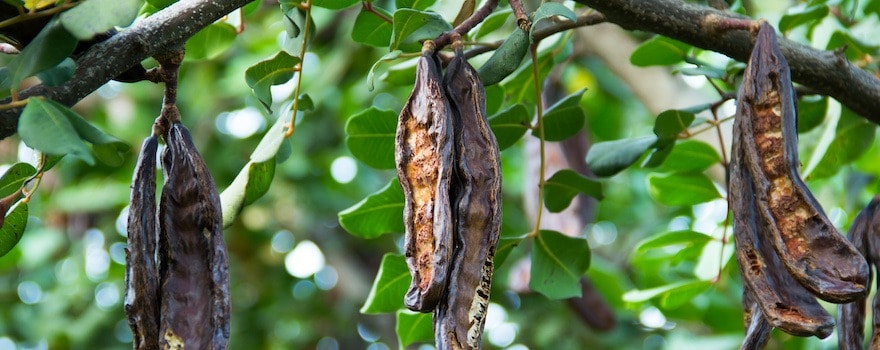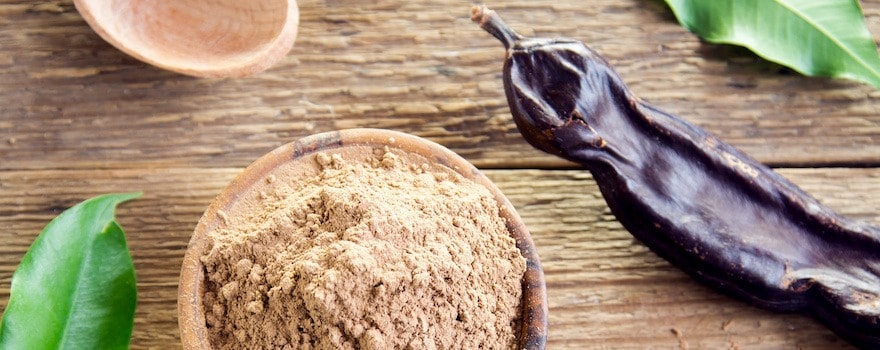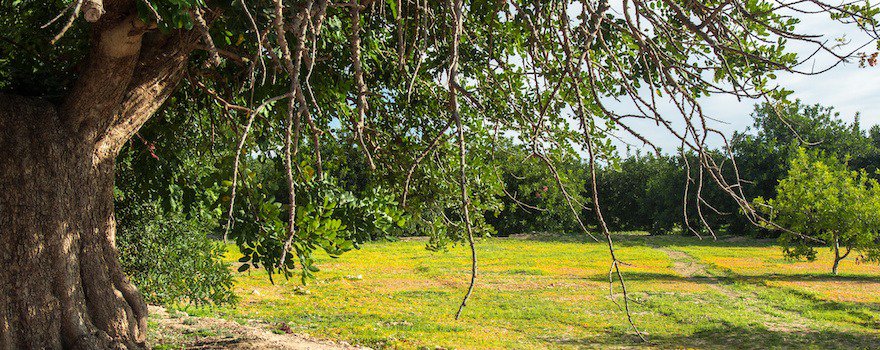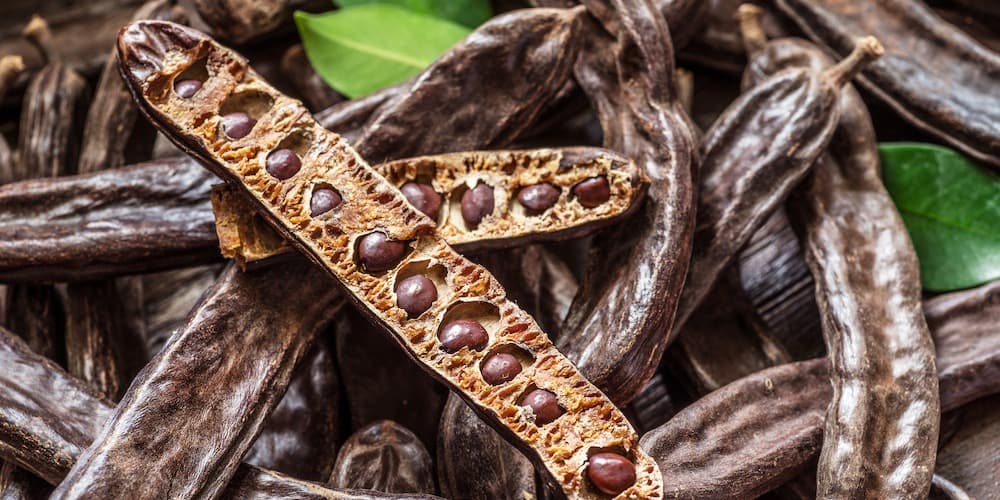BENEFITS OF CAROB
✓ Helps defend the body
✓ Relieves digestive issues
✓ Helps with weight loss
✓ Reduces cholesterol levels
✓ Regulates blood sugar levels
What is carob?
When people talk about carob, they commonly mean the fruit of the carob tree (Ceratonia siliqua). This tree belongs to the Fabaceae family, or legumes (like lentils and fenugreek!), which includes many trees native to tropical or Mediterranean regions.
The carob tree prefers warm, dry climates. Without these climatic conditions, it cannot produce fruit. That is why the carob tree is a ‘thermophilic’ tree. The carob tree grows mainly around the Mediterranean (Portugal, Spain, the Maghreb…) and in Turkey.

The longevity, massive trunk, rough bark, giant leaves and hanging pods of the carob tree make it a true botanical curiosity. But in cooking and herbal medicine, it is above all the carob seeds that are of interest.
After flowering, the carob tree produces long green pods, each containing about a dozen seeds. But before harvesting them, you must wait until the following summer : the pod is then at maturity and has taken on a lovely brown color. The carob pods are the origin of its scientific name. “Ceratonia ” comes from the Greek “κεράτια” meaning “little horn” in reference to the curved shape of the pods. The Latin term “siliqua“, for its part, simply denotes a pod.
Even today, the carob tree is the focus of many uses. Its wood is prized in marquetry, and its seeds are used in certain soft drinks, for the production of gum, or in confectionery.
Carob seeds are also an excellent substitute for chocolate in sweet recipes. They are used to make carob seed flour, which is naturally gluten-free.
Today, Spain, Morocco and Italy are the three main carob producers. The seeds are not only sold to the food industry. Their content of fiber, protein, vitamins and antioxidant compounds also makes them very interesting superfoods for health.
Nutritional composition
- Sucres : glucose, saccharose
- Amidon
- Fibres
- Protéines
- Vitamines : A, B, B2, E, D2
- Tanins : acide gallique
- Actifs antioxydants : polyphénols, myricétine, quercétine
- Pectine
- Minéraux et oligo-éléments : potassium, magnésium, calcium, phosphore, silice, fer

The benefits of carob
🛡 Supports the body’s defenses
Carob seeds contain a significant amount of antioxidant compounds such as polyphenols. These organic molecules, found in many plants, effectively combat free radicals and limit the damage they cause.
The vitamins of carob also contribute to the body’s defenses. The vitamin A, for example, supports the functioning of the immune system and slows cellular aging, just like the vitamin E. As for vitamin B2 (or riboflavin), it is involved in the production of many enzymes and in the regeneration of glutathione, a powerful antioxidant.
Finally, carob seeds also contain iron, which is a component of the body’s antioxidant enzymes.
This study from the University of Bonn, carried out directly on carob pods, shows their high concentration of polyphenols.
♻️ Relieves digestive issues
Carob seeds are a valuable aid for relieving digestive and gastrointestinal disorders: difficult digestion, diarrhea, constipation, heartburn, stomachaches, sluggish bowels, colon irritations…
Thanks to its high fiber content (40 g per 100 g), carob contributes to the proper functioning of intestinal transit. It is an excellent antidiarrheal but also a natural laxative that eases the passage of stool through the colon. In this respect, they can be compared to chia seeds.
The seeds also contain pectin, a plant substance that protects the gastric mucosa and intestinal walls. Carob also helps improve gut flora thanks to its prebiotic effect.
This study from Ibn Khaldoun University (Tunisia) and Abdelhamid Ibn Badis University (Algeria), conducted directly on bacterial strains, shows how carob improves the proliferation of the “friendly” bacterium Lactobacillus fermentum present in the digestive tract.
🍳 Reduces cholesterol levels
Many studies have confirmed carob’s ability to reduce levels of “bad cholesterol” (or LDL cholesterol) and triglycerides in the blood. This effect is due to the presence of polyphenols and soluble fiber.
At the same time that they increase levels of “good cholesterol” (or HDL cholesterol), the polyphenols in carob fight the oxidation of LDL cholesterol. They thus prevent the formation of plaques in the arteries, which leads to atherosclerosis.
Soluble fiber also helps lower cholesterol levels by limiting the absorption of carbohydrates and fats.
This study from King Abdulaziz University (Saudi Arabia), conducted on rats, demonstrates that carob can be effective in reducing hypercholesterolemia. This other study from the University of Potsdam, conducted on patients with high blood cholesterol, shows that consuming carob reduced their LDL cholesterol and triglyceride levels.
🍭 Regulates blood sugar levels
Carob may be beneficial for people with diabetes because it has a hypoglycemic effect. It helps control and reduce blood sugar levels despite its high glucose and sucrose content. Indeed, the large amount of soluble fiber it contains is enough to slow the absorption of these sugars.
However, be careful: it tends to increase insulin sensitivity and to interact with antidiabetic medications. If you have diabetes, consult your doctor before consuming carob.
In this study from the Agricultural University of Athens, conducted on adults, researchers examined the effects of carob on blood glucose.
🏃🏼 Helps with weight loss
Because of its high fiber content and its low fat content, carob is a good ally when you want to lose weight. The fibers contained in the seeds are so-called “soluble” fibers: once in the stomach, they swell, thicken and form a kind of gel. Thanks to this process, carob promotes the feeling of satiety and acts as a natural appetite suppressant.
Because of its richness in nutrients, carob is also useful for avoiding deficiencies during a diet. Of course, like cocoa, it should not be consumed in excess as it is relatively high in calories (220 kcal per 100 g).
More studies are needed to evaluate the effectiveness of carob for weight loss.

How to consume carob?
Carob powder or flour
In health food and specialty stores or online, you can easily find carob in powder or flour form. It is obtained after grinding the entire pod of the carob tree. This is the form most often used to replace chocolate in sweet preparations. It is also used in the manufacture of dietary supplements in capsule form.
Carob powder or flour mixes easily into the pastry recipes or simply into beverages (smoothies, milkshakes…).

Carob seed flour or carob gum
Carob seed flour, also called carob gum, should not be confused with carob flour. Indeed, as its name indicates, carob seed flour is obtained after grinding the seeds only.
It’s a natural thickener very often used in the food industry (under the designation E410) because it contains galactomannan, a complex sugar made of starch.
In cooking, carob gum is used to thicken sauces, soups, or to make homemade ice cream creamier. Carob seed flour is naturally gluten-free.
Carob syrup
Carob syrup, or carob molasses, is obtained from the pulp of the pod. It is a form that is harder to find than the flour or the gum.
This syrup can replace honey or sugar in cake recipes, hot and cold drinks, or be spread on bread.

Carob and nopal
The combination carob/nopal is recommended to accompany weight loss. Indeed, nopal, better known as prickly pear cactus, is a natural appetite suppressant and a fat absorber. It also aids digestion thanks to its high fiber content.
Carob dosage
⚖️There isn’t really a recommended dosage for taking carob. However, the daily dose should not exceed 30 g for an adult (or 15 g for a 10 kg child).
⚖️In cooking, carob is used in the same proportions as cocoa. If you take it as a dietary supplement, always follow the doses indicated by the manufacturer.
⏳Carob capsules are preferably taken at lunchtime or 1 hour before as part of a weight-loss regimen, to promote the sensation of fullness.
⏳A 1-month course may help reduce bad cholesterol.
💊In capsules : up to 2 per day for 330 mg capsules
🥄In powder : up to 30 g per day, every 2 hours
💧In syrup : can be consumed throughout the day
Contraindications and side effects
Carob consumption has some contraindications. Therefore, it is not recommended for the following people :
- Par mesure de précaution, les femmes enceintes ou allaitantes doivent éviter de prendre de la caroube pendant une longue période.
- La caroube agissant sur la glycémie et la résistance à l’insuline, les personnes diabétiques doivent demander l’avis de leur médecin avant d’en consommer.
- Les personnes souffrant de problèmes rénaux doivent éviter de prendre d’en prendre car elle exerce une action sur le taux d’urée et de créatinine.
- La caroube ne doit pas être prise en cas d’anémie sévère ou de carence en oligo-éléments.
- Sa consommation est déconseillée chez les nourrissons et les enfants souffrant d’une insuffisance pondérale.
There are few side effects after taking carob. Rare skin rashes have been reported.
History, cultivation and market of carob
Morocco, the world’s 2nd largest carob producer
In Morocco, carob cultivation (or « tislighwa » in the Berber language) covers an area of 30,000 hectares and supports the livelihoods of many farmers. Nearly one million carob trees populate the valleys of the province of Tiznit in the south of the country.
Each tree can produce up to 800 kg of carob pods per year from the 4th year. But all parts of the tree are useful. The leaves, for example, are eaten by livestock. The flowers, which appear from August to October, are also appreciated by bees, whose work produces carob honey.

The carob tree against soil erosion
The carob tree offers significant ecological value. The tree has been introduced in many countries to combat erosion and regenerate depleted soils. It also serves as an excellent natural firebreak and provides shade to other plants.
Today, the carob tree is increasingly visible in the United States, South Africa, Australia, the Philippines, and Iran.
Report by Julia Perez and Charlotte Jean
Sources and scientific studies
Papagiannopoulos M, Wollseifen HR, Mellenthin A, Haber B, Galensa R, 2004. Identification and quantification of polyphenols in carob fruits (Ceratonia siliqua L.) and derived products by HPLC-UV-ESI/MSn.
aR. BENGUIAR, aR. BENARABA, bA. RIAZI, 2013. Effect of carob extract on the growth of two probiotic candidates: Lactobacillus fermentum and Lactobacillus rhamnosus.
El Rabey HA, Al-Seeni MN, Al-Ghamdi HB, 2017. Comparison between the Hypolipidemic Activity of Parsley and Carob in Hypercholesterolemic Male Rats.
Zunft HJ, Lüder W, Harde A, Haber B, Graubaum HJ, Koebnick C, Grünwald J, 2003. Carob pulp preparation rich in insoluble fiber lowers total and LDL cholesterol in hypercholesterolemic patients.
Papakonstantinou E, Orfanakos N, Farajian P, Kapetanakou AE, Makariti IP, Grivokostopoulos N, Ha MA, Skandamis PN, 2017. Short-term effects of a low glycemic index carob-containing snack on energy intake, satiety, and glycemic response in normal-weight, healthy adults: Results from two randomized trials.



